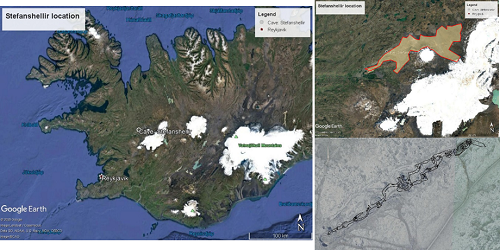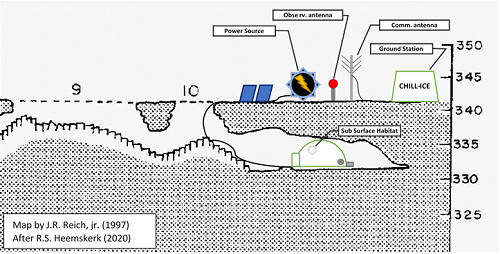CHILL-ICE: Construction of a Habitat Inside a Lunar-analogue Lava-tube: Iceland Campaign of EuroMoonMars
- 1VU Amsterdam, Amsterdam, Netherlands (marcvheemskerk@gmail.com)
- 2EuroMoonMars
- 3Hague University of Applied Sciences, Delft, Netherlands
- 4Explaneta Space Solutions (sabrina.kerber@euromoonmars.space)
- 5Technological University Dublin, Dublin, Ireland
- 6Delft University of Technology, Delft, Netherlands
- 7ESA/ESTEC, Noordwijk, Netherlands
In May 2021, a group of students and young professionals from EuroMoonMars will construct a lunar-analogue habitat inside a lava tube in Iceland, known as CHILL-ICE.
As a preparation for semi-permanent humanned missions to the lunar surface, analogue field tests on Earth will greatly improve the chance of a mission success. Looking at prospective habitat locations in or on the lunar surface, lava tubes may present an excellent opportunity in terms of safety and efficiency. These locally occurring features provide a rigid structure with a solid ground, and therefore offer protection from radiation, temperature variations, regolith, and micrometeorite impacts [1]. Furthermore, the unaltered rocks and minerals inside lunar lava tube systems will grant a unique insight into the origin of the Moon, and with that, the Earth [2].
Lava Tubes
Lava tubes on Earth are most commonly found in areas with deep-mantle volcanic activity, such as ‘hot spots’: places where mantle plumes arrive at the surface (Hawaii, Iceland, Canary Islands). Geochemically speaking, the basaltic rocks present at these locations on Earth are quite comparable to their lunar counterparts in major element compositions. As most of the larger lava tubes on Earth are located on oceanic islands, they are highly suited to explore the psychological factors of being remotely distanced from the rest of the Earth. Colder regions, such as on Iceland or at the high peaks of Mauna Loa on Hawaii, are preferred for analogue habitats due to less biochemical weathering of the environment. The high latitude of Iceland further aids the lunar-day simulation aspect of an analogue habitat, as there can be over 20 hours of sunlight in the summer, and only 4 hours of sunlight in the winter. The EuroMoonMars and future EXTAR teams are therefore planning to set up a lunar-analogue habitat inside a lava tube on Iceland.
Earlier campaigns
In September 2018, a reconnaissance campaign was organized to scout multiple lava fields across Iceland for their suitability to host a lunar analog habitat [3]. The most promising site found was the Surtshellir-Stefanshellir cave system in the Hallmundarhraun lava flow in the Western part of Iceland, see Figure 1. At the easternmost part of the Stefanshellir lava tube, there is a large open gallery with a relatively flat surface within the tube. This would be an optimal location for the construction of a lava tube habitat.

Figure 1: Location of the Stefanshellir cave system. Top left image shows the location in Iceland, top right shows the Hallmundarhraun lava field (in light yellow). Bottom right shows an overlay of the Stefanshellir cave system as drawn by J.R. Reich jr., in 1975, over aerial footage.
Upcoming scout mission
This year a follow-up scout mission to the lava tube systems of Hallmundarhraun is planned for the 28th of June until the 4th of July 2020. The main goal is to investigate the lava tube and its direct surroundings into a much greater detail. Inside Stefanshellir, the aim is to make at least two 180-degree 3D movies for a virtual walkthrough tour, take precise measurements of the dimensions of the gallery, and 360 degrees pictures for a model. On the surface, the focus lies on making aerial maps to scout for visible signs of the subsurface lava tubes [4] and setting up communications and solar observational antennae.
Besides investigations regarding the lunar analog mission, geological fieldwork to the lava field will be performed to create a clearer reconstruction between Stefanshellir and other lava tubes within Hallmundarhraun. Directly located to the east of Stefanshellir, lies Surtshellir, a maze-like cave that is unlikely to have formed in one event. Another lava tube is located directly to the west, called Hulduhellir, or “secret cave” [5], as it has no openings to the surface and is known only through ground penetrating radar and magnetometric studies. There are in total another seven lava tubes in the lava flow confirmed and discovered thus far, but it is likely that there are other, still pristine and unopened lava tubes yet to be found.
Simulation mission
The final lunar analog habitat will be constructed end of May 2021. Besides earlier campaign objectives, the simulation mission will focus on the feasibility of setting up a lunar tube habitat in-sim. This means that the habitat should be deployable by four astronauts in a tight and possibly dark environment within ten hours. Other instruments will be deployed out of simulation, this would compare to the deployment of instruments via robotic missions in earlier stages of lunar habitation. Figure 2 provides a rough overview sketch of some crucial instruments used in the simulation mission.

Figure 2: Rough sketch of the planned base for the CHILL-ICE campaign in May 2021. The subsurface habitat’s shape is still to be determined and will not (yet) include any large life support systems, such as greenhouses or water replenishment systems. On the surface, several instruments will be deployed out-of-simulation; comparable to robotic deployment in lunar missions.
Even with a lightweight, partially inflatable, habitat, this is expected to take up the largest part of the first mission. From the ten days set out for the campaign, only two and a half day will be spent in simulation; the rest of time will be to conduct further research to the terrain and its origin, other ISRU objectives, drone mapping, communication protocols, solar observations, (aerial) gravimetric, LIDAR, and magnetometric studies, and of course training in setting up the habitat locally in an efficient and safe manner.
We would like to thank Space Iceland, 4th Planet Logistics, Prof. Bernard Foing, EuroMoonMars, and ILEWG for their great support during our campaign.
[1] M.V. Heemskerk et al., LPSC50, #1693, (2019)
[2] C.L. York et al., LPI Joint Workshop on New Technologies for Lunar Resource Assessment, (1992)
[3] M.V. Heemskerk et al., EGU2019-17503-1, (2019)
[4] P. Lee et al., LPSC50, #3118, (2019)
[5] C. Wood et al., Expedition Report Hallmundarhraun 2003 Iceland, (2004)
How to cite: Heemskerk, M., Pouwels, C., Kerber, S., Downes, E., Heemskerk, R., and Foing, B.: CHILL-ICE: Construction of a Habitat Inside a Lunar-analogue Lava-tube: Iceland Campaign of EuroMoonMars, Europlanet Science Congress 2020, online, 21 September–9 Oct 2020, EPSC2020-901, https://doi.org/10.5194/epsc2020-901, 2020

